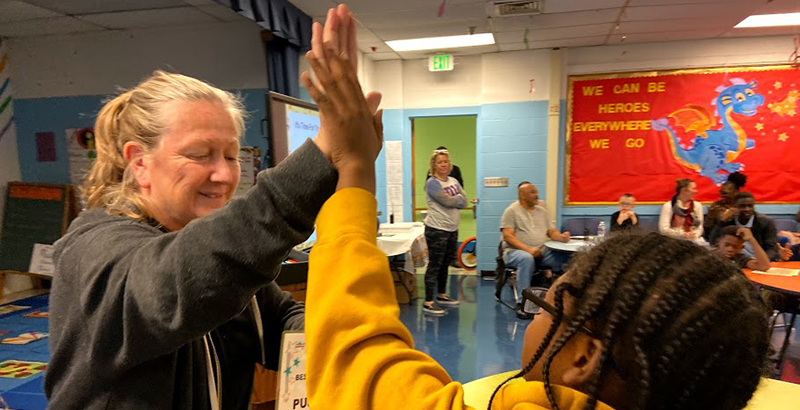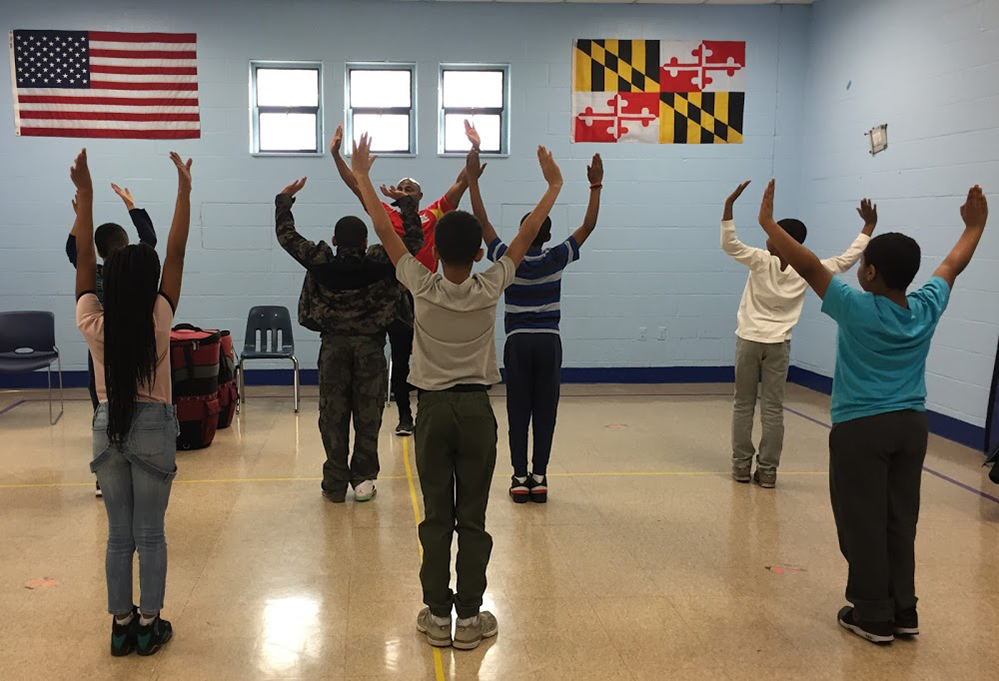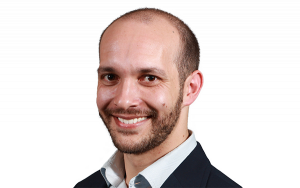Eden: ‘Not a Lot of Schools Can Handle Kids With Behavior Problems’ — Here’s a Baltimore School That Can, but Not Through ‘Full Inclusion’

“I really want people to know that just because our school has a lot of kids with behavior problems doesn’t mean it’s a bad school,” a fifth-grader whom I’ll call Carl told me. “If you’re as smart as me,” he continued, “you’ll realize that if it’s a behavior school then it’s actually a great school. Because not a lot of schools can handle kids with behavior problems.”
Carl attends Sharp-Leadenhall Elementary School, a specialized school for students with severe emotional and behavioral disabilities (EBD) in the Baltimore City School District. Sharp-Leadenhall has the capacity to serve 50 students (current enrollment is 32) with 25 instructional staff.
Sharp-Leadenhall’s principal, Dr. Lillian Cockrell, emailed me after reading an article I published arguing that the pressure to keep students with emotional and behavioral disabilities in traditional schools can do more harm than good, and invited me to visit her school “to see how a good EBD program is organized.”
“Special education departments today are all about ‘full inclusion,’” she explained. “And I get that, up to a point. But the other side of saying, ‘We’re doing full inclusion’ is, ‘We don’t have special programs for special education students who need them.’”
The morning of my visit, Cockrell and seven staffers stood in the hallway, greeting every student coming off the buses. Some kids came with hugs for everyone. Others looked dazed or angry.
After 10 minutes, a call came over the radio and I accompanied Cockrell to see what was happening. By the time I reached the classroom, the situation had been defused and the student was walking with a social worker to the Behavior Intervention Office (BIO). He was guided to a cubby where students are asked to remain until they become responsive to verbal direction. He refused to say what happened.
“Are you sure,” coaxed the social worker, “you don’t want to talk about it?”
The student stuck up his middle finger.
“I’ll take that as a no,” the social worker replied, nonplussed.
Later, the social worker explained the situation: “He started tearing up his math work. Throwing it and threatening his teacher. He’s oppositional, but he’s not impulsive. He just wanted to get out of the work and wanted everyone’s attention. But he knows that he’ll have to do the work before he can go back to class.”
When I left the office a few minutes later, the student was beatboxing angrily, refusing to respond to the three men staffing the room. Forty-five minutes later, he calmed down, finished his work and returned to class.
Throughout his “crisis,” the staff remained impassive and unflappable.
“We provide students what they need therapeutically,” explained Cockrell, who began her career as a psychotherapist. Her philosophy is that staff must never be reactive; reacting to students’ behavior puts them in charge. By presenting a calm face and using consistent language in response to behaviors, staffers give students a greater sense of order, and they can think better beyond immediate crises to broader patterns in a student’s behavior.
“You have to have very tough skin,” explained Patrick Autry, who teaches a life skills class to students who are several years behind grade level. “I’ve been called everything. I’ve been threatened. But it’s never personal. It’s not you. It’s something that’s going on with them.”
Michelle Hiegel, Sharp-Leadenhall’s lead math teacher, said new students are “so cute because they get here and do something very disruptive and we just kind of give them a look like, ‘That’s all you got?’ And they’re kind of like, ‘OK, I guess these people can handle me.’”
One mother, Amber Maczka, told me that enrolling her son in Sharp-Leadenhall was an “unexplainable relief.” Teachers at his old school would tell her, “These are his behaviors. He’s not getting an education. This isn’t the right placement for him.” But she found it extremely difficult to convince the school district to transfer him out.
“I had to hire people to advocate for him,” she said. “He was not getting an education.” His behavior was not merely disruptive; it was frequently violent. Teachers told Maczka they were scared of her son because “he would attack them every single day.” Yet despite his daily attacks, it took many, many months of a mother’s fierce advocacy before the school finally agreed that “full inclusion” was not in her son’s best interest.

“I didn’t believe it would be any different” at Sharp-Leadenhall, Maczka said. “I came to them with a ‘don’t mess with my child’ mentality, and they just completely blew my mind with their capabilities.”
Her son’s behavior has improved immensely. He still has serious outbursts on occasion and sometimes needs to be physically restrained. But Maczka trusts the staff to do so responsibly. “Dr. Cockrell always calls me and says, ‘This is what happened, this is why, this is what we’re working on to help improve things.’”
“Of course, it’s scary as a mom for anyone to touch your child,” she said. “But there are times when it needs to happen. When he needs to be removed quick, in a hurry, so that everyone else is safe. As long as it’s done in a proper way, I have no problem.”
Nor does her son. “The last time I asked him what he wanted to be when he grew up,” she said, “he named someone in the BIO room and said, ‘I want to be him. I want to be a person in a BIO room who helps kids like me.’”
Maczka believes that getting her son transferred to Sharp-Leadenhall shouldn’t have been so difficult. When asked why she thought it was, she replied, “I don’t know. Maybe it’s the money?”
The school is very expensive. Its budget is $1.973 million, which at current enrollment comes out to $68,000 per pupil. So it’s hardly surprising that a school district looking to contain costs would not default to transferring students with emotional and behavioral disabilities to specialized schools like Sharp-Leadenhall.
But money is only part of the reason. The other part lies in the ethos of “full inclusion,” the reigning presumption in special education that keeping students in traditional settings is inherently good and placing them in separate settings is inherently bad. Taken together, these two forces encourage district bureaucrats to cloak the shortchanging of students with disabilities with social justice rhetoric.
“We went to a more ‘inclusive’ model,” Cockrell reflected, “because special education students were being ostracized, pushed to the margins. But since [the Individuals with Disabilities Education Act], districts have focused on being fully inclusive, and the pendulum has gone too far for some of our students, who are struggling in that inclusive environment.”
She pointed to the rise of “room clears” elsewhere as an unintended but inevitable by-product. “Teachers are having to remove the rest of the classroom and leave the student there in crisis. … I’ve seen a school in another district where a student purposely trashes the classroom and goes to the principal’s office and gets to play with an iPad. What cause-and-effect life lesson is that message sending? … That’s not reality.” Baltimore City, she said, is the best district she has ever worked with when it comes to properly placing and supporting students with emotional and behavioral disabilities.
Schools in other districts, though, resort to perpetually suspending these students. When Luevana Cooper’s son attended a public school in Arizona, “they just thought, ‘He’s a troubled kid; we’re just going to suspend him for any issue.’ He’d throw chairs, yell at teachers, actually physically assaulted a teacher, scratched her up bad and tried to bite her. They just kept suspending and suspending and suspending.”
Now enrolled at Sharp-Leadenhall, he no longer behaves like that. “Sometimes he’ll get into moods,” Cooper explained, “and you have to guess. But they’ve done a great job guessing and I’m just, like, ‘Dude! You get him!’ … You can tell the difference between a school that doesn’t care and a school that does.”
“It’s like chess,” said Lauren Steinmueller, who teaches third- and fourth-grade math, “because you have to think three to four steps ahead and predict what will happen based on what they do and how you could react. At the end of the day, your mind can be fried because you’re making so many small decisions. I’ve worked in inclusion classes. You can’t do this there.”
Once staff can successfully minimize negative behaviors, student learning can skyrocket. Cooper told me her fourth-grade son entered Sharp-Leadenhall reading at the first-grade level, “and now I think he’s almost on grade level.”
Carl told me, “At my old school, there was so many kids and they would be super rowdy and it took us three days to do one lesson. Here, we could finish two lessons in 30 minutes. I did two lessons in 30 minutes without the teacher. … It’s just so many good people here that it’s hard not to do good. I think more people should come to this school.”
Many disability rights advocates disagree. A report by the National Council on Disability declared, “Government enforcement of … inclusion and integration … is essential to breaking the school-to-prison pipeline. The overall inclusion of students with disabilities in the general education classroom has increased over the past decade, but current statistics show that enforcement activities have not adequately targeted students with disabilities at risk of entering the school-to-prison pipeline.”
Patrick Autry has heard that argument plenty of times, and he says that it’s “one of the most wrong opinions that I could ever imagine.” He explained how the “school-to-prison pipeline” is really formed:
“You have kids who are incapable of managing their emotions sitting in classrooms with a bunch of kids who are way ahead of them. If I’m in a class with kids who are three grade levels above me and you call on me in class, I’m going to act out. What’s going to happen is that you get frustrated — ‘Why should I even come in?’ So you stop coming. Then you’re on the streets. You’re doing crime. You’re in jail. This school isn’t part of the pipeline. This is how we stop that pipeline. … People have to get over this stigma of thinking these schools can’t help. If they’re run correctly and properly, they can do amazing things.”
Cockrell said that her goal is to “interrupt that pipeline” by bringing students closer to grade level and equipping them with an emotional “suit of armor” to re-enter a traditional school, navigate it successfully and graduate prepared for a productive life.
That armor is forged partly through the school’s Positive Behavior Intervention and Supports (PBIS) program. Students can receive up to 50 points a day for behavior and redeem those points during Fun Fridays and on monthly field trips. Carl told me this incentive structure has “helped me realize what I’m doing before I do it, and that helps me be good and better.”
The small student-to-staff ratio allows teachers to create tailored social and moral ecosystems for students.
“It’s about making choices,” Autry explained. “You have to teach them that choices have consequences. Like, ‘Hey, if I push a kid out of a chair, this will happen.’”
With only four students, “I high-five everybody. You got to make them feel special. … But if this is the consequence, then this is the consequence. There has to be accountability.”
After all, he tells his students, “People want to help children. But no one wants to help a grown man. When you turn 18, this all goes out the window.”
At the end of the school day, most students filed onto the buses with a smile. One did a little dance to celebrate getting a perfect score for behavior. A few left looking sullen.
One didn’t leave. He was in crisis and couldn’t stop screaming. The bus driver offered to wait 10 minutes to see if he would respond to verbal direction, but Cockrell looked at the student and said, “He is not going to be ready in 10 minutes.”
She was right. First surrounded by eight teachers, then only by two when staff suspected the student felt unnerved by the attention, he went from half-hugging, half-hitting a teacher to leaning against her as she tried calming him by walking with him up and down the hallway.
“Some of our kids have a hard time leaving,” Cockrell explained.
The bus driver left. Five minutes later, I left too. He was still screaming. Ultimately, a family member had to come pick him up. G-d willing, after a few more years of being attended to closely by highly skilled teachers, he will be able to forge a suit of armor to navigate a traditional public school and, eventually, find gainful employment.
If he were kept at a traditional school, he would almost certainly have been lost. How many students out there are like him but whose screams are quieter?
“This is my mission. This is my ministry,” Cockrell said. “Something has to be done. If we don’t shift that pendulum back from full inclusion, we are amplifying that pipeline. It is expensive, but what’s the alternative?”
Although it costs almost $70,000 per pupil, that expense must be weighed against the costs produced by systems that hold “full inclusion” to be the highest value: systems that keep an untold number of students like Maczka’s son in traditional public schools, even when their persistent disturbing or violent behavior disrupts learning and makes students and teachers feel unsafe.
“I want other parents to know that there are other options out there. Good options. Safe options,” Maczka said. But, sadly, although this was true for Maczka in Baltimore City, it is not always so; in many districts, the ethos of “full inclusion” holds sway, telling educators that keeping students like Maczka’s son in traditional schools counts as success, and sending him to a more appropriate setting where he can grow behaviorally and academically counts as failure.
Cockrell is confident that the pendulum will soon start to swing back and that properly serving students with emotional and behavioral disabilities by providing them an appropriate education in specialized settings will become a civil rights cause.
For that to happen, however, policymakers would need to lift their eyes above their spreadsheets and look directly at these students and the schools that serve them.
Sharp-Leadenhall would be an excellent place for them to start.
Max Eden is a senior fellow at the Manhattan Institute, specializing in education policy.
Get stories like these delivered straight to your inbox. Sign up for The 74 Newsletter

;)
